Technology
Smart textiles for personalized sports and healthcare: A comprehensive review

image:
- This review provides comprehensive structural design strategies for the manufacturing of smart textiles, covering fibers, yarns, and fabrics and offers professional guidance for product development in this field.
- The fundamental performance criteria for sports-oriented smart textiles have been provided, highlighting the key attributes required for their optimal functionality in athletic applications.
- This review systematically introduces the diverse roles of smart textiles in specific sports scenarios and the stringent requirements they must meet to perform effectively in these environments.
view more
Credit: Ziao Xu, Chentian Zhang, Faqiang Wang, Jianyong Yu, Gang Yang, Roman A. Surmenev, Zhaoling Li, Bin Ding.
A groundbreaking review on smart textiles has been published in Nano-Micro Letters, led by Professor Zhaoling Li and Professor Bin Ding from Donghua University, Shanghai, China. This comprehensive study explores the latest advancements in the design, preparation, and application of smart textiles, highlighting their potential to revolutionize personalized sports and healthcare. The research provides valuable insights into how these innovative textiles can seamlessly integrate sensing and monitoring capabilities with the comfort and flexibility of traditional fabrics.
Why Smart Textiles Matter
- Enhanced Comfort and Functionality: Smart textiles combine the breathability and flexibility of traditional fabrics with advanced sensing capabilities, making them ideal for long-term wear during sports and health monitoring.
- Real-Time Data Collection: These textiles can monitor vital signs, joint movements, and environmental conditions in real-time, providing valuable insights for athletes and healthcare professionals.
- Versatility in Applications: From sports performance enhancement to health monitoring, smart textiles offer a wide range of applications, including wearable sensors, energy harvesting, and self-powered devices.
Innovative Design and Mechanisms
- Fiber-Level Innovations: The review discusses various types of smart fibers, including coated, intrinsic, coaxial, and composite fibers, each offering unique advantages for different applications. For example, coated fibers can be tailored with functional materials to enhance their sensing capabilities.
- Yarn and Fabric Design: Smart yarns and fabrics are created through innovative spinning and weaving techniques, allowing for the integration of multiple functionalities while maintaining the textile’s structural integrity. Techniques like core-spinning and braiding are highlighted as effective methods for creating durable and functional textiles.
- Integration with Electronics: The review explores the integration of microelectronic systems with textiles, enabling the development of wearable devices that can monitor health and performance metrics in real-time.
Applications in Sports and Healthcare
- Vital Signs Monitoring: Smart textiles can monitor heart rate, body temperature, and respiratory rate with high accuracy, providing essential data for health management.
- Joint Movement Tracking: These textiles can track joint movements and angles, helping athletes optimize their performance and prevent injuries.
- Sweat Analysis: Smart textiles can analyze sweat biomarkers, such as lactate and glucose, offering non-invasive methods for monitoring physiological conditions.
- Data Transmission: The integration of wireless communication technologies allows for real-time data transmission, enabling remote monitoring and analysis.
Future Outlook
- Scalability and Practical Applications: The review emphasizes the need for scalable and cost-effective manufacturing processes to bring smart textiles from the lab to the market.
- Further Research: Future work may focus on improving the durability, accuracy, and energy efficiency of smart textiles, as well as exploring new materials and fabrication techniques.
- Integration with IoT and AI: The potential integration of smart textiles with the Internet of Things (IoT) and artificial intelligence (AI) is highlighted as a promising direction for future research, enabling more intelligent and responsive wearable systems.
Conclusion
Smart textiles represent a significant advancement in wearable technology, offering a versatile and comfortable platform for sports and healthcare applications. This review provides a comprehensive overview of the current state of smart textiles, highlighting their potential to transform personalized sports and healthcare. As research continues to advance, smart textiles are poised to become an integral part of the next-generation wearable devices, enhancing human performance and well-being.
Stay tuned for more groundbreaking research in the field of smart textiles as Professor Zhaoling Li and Professor Bin Ding continue to push the boundaries of wearable technology!
Journal
Nano-Micro Letters
Method of Research
Experimental study
Article Title
Smart Textiles for Personalized Sports and Healthcare
Article Publication Date
25-Apr-2025
Disclaimer: AAAS and EurekAlert! are not responsible for the accuracy of news releases posted to EurekAlert! by contributing institutions or for the use of any information through the EurekAlert system.
Technology
Best gaming keyboards 2025: Top picks for performance, comfort, and customisation

The gaming keyboard market in 2025 has evolved far beyond being just an accessory for PC gamers. What was once a niche category is now a critical part of the gaming setup, blending precision engineering with customisation and comfort. As competitive gaming continues to grow and everyday users demand more from their gear, keyboards are being increasingly designed to meet both performance and lifestyle needs.
Keyboards today are defined by speed, responsiveness, and adaptability. From faster actuation to improved durability and ergonomic layouts, the focus is on enhancing gameplay while supporting longer hours of use. Many now offer features that allow players to tailor their experience, whether through software control, hot-swappable components, or multi-device connectivity, making them versatile tools for both gaming and productivity.
At the same time, design and personalisation have become just as important as raw performance. Sleek builds, wireless functionality, RGB lighting, and compact layouts are giving players more choice than ever to match their setup and style. The result is a market where the keyboard is no longer seen as a one-size-fits-all device but as a central piece of technology that reflects both the way people play and the way they work.
Razer Huntsman V2


The Razer Huntsman V2 is a flagship gaming keyboard built to deliver unmatched speed, precision, and control. Featuring Razer’s Analogue Optical Switches, it allows users to customise actuation points for every key, blending the benefits of digital and analogue input in one device. Its aluminium matte top plate, durable doubleshot PBT keycaps, and magnetic wrist rest combine premium build quality with long-lasting comfort. At the same time, Chroma RGB underglow lighting adds visual flair to any setup.
For gamers, the Huntsman V2 offers advanced features designed to enhance both performance and versatility. Rapid Trigger Mode enables instant key resets for faster reactions, while dual-step actuation allows single keys to perform multiple commands. With onboard profile storage, a multifunctional digital dial, dedicated media keys, and USB passthrough, it provides both convenience and customisation, making it an ideal choice for competitive play and everyday use alike.
Key features and benefits
- Analogue Optical Switches: Customisable actuation points that deliver both analogue and digital input.
- Rapid Trigger Mode: Enables instant key resets for ultra-fast responsiveness.
- Doubleshot PBT keycaps: Durable, textured finish that resists wear over time.
- Chroma RGB lighting: Per-key customisable lighting with 16.8 million colour options and underglow.
The best wireless gaming keyboard
Corsair K100 Air Wireless


The Corsair K100 Air Wireless is an ultra-thin mechanical gaming keyboard built for speed, versatility, and style. Featuring CHERRY MX Ultra Low Profile tactile switches, it combines the crisp feedback of a true mechanical keyboard with a slim, modern design that’s comfortable for long gaming or work sessions. Its sleek frame is paired with per-key RGB lighting and full iCUE support, allowing users to customise effects, create macros, and sync with the rest of their Corsair setup.
Designed for competitive performance and everyday flexibility, the K100 Air Wireless offers hyper-fast connectivity through Corsair Slipstream Wireless, Bluetooth 4.2, or USB wired mode. It delivers up to 50 hours of battery life with RGB on, or up to 200 hours with lighting off, making it dependable for extended use. With dedicated media keys, a volume roller, macro support, and a polling rate of up to 8,000Hz, it ensures both precision and convenience for gamers and professionals alike.
Key features and benefits
- Ultra-thin frame: Slim, modern design with premium comfort for extended use.
- CHERRY MX Ultra Low Profile switches: Crisp, responsive tactile performance.
- Wireless versatility: Supports Slipstream, Bluetooth 4.2, and wired USB connections.
- Long battery life: Up to 50 hours with RGB lighting, or 200 hours with lighting off.
Logitech G915 TKL
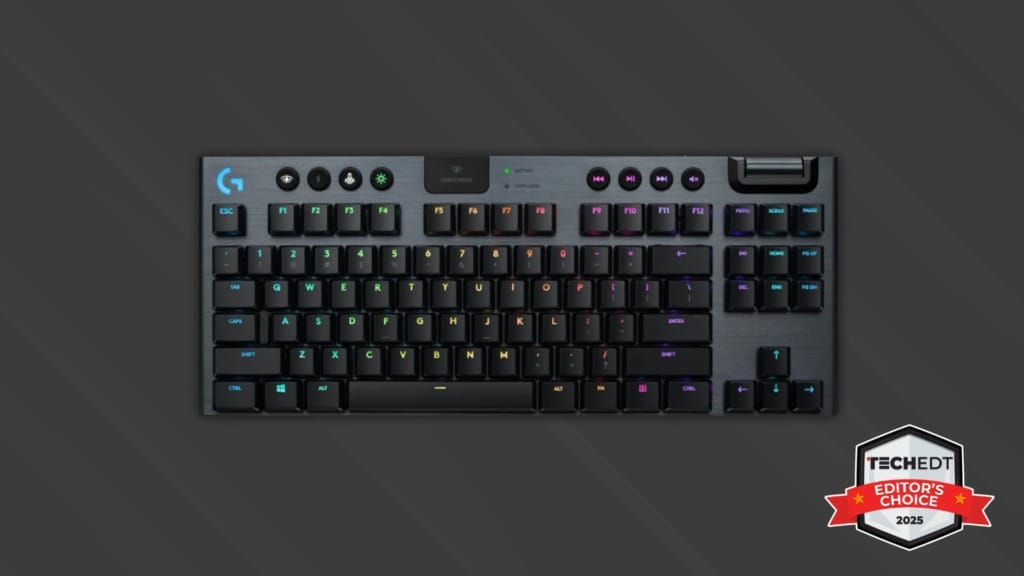

The Logitech G915 TKL is a tenkeyless wireless mechanical keyboard designed for sleek performance and portability. Built with low-profile GL tactile switches, it delivers precise, responsive keystrokes in a slim form factor that takes up less desk space while maintaining comfort and durability. Its lightweight aluminium alloy frame ensures a premium feel, while per-key LIGHTSYNC RGB lighting offers full customisation and vibrant effects to match any setup.
Engineered for flexibility, the G915 TKL features Logitech’s LIGHTSPEED wireless technology for ultra-low latency gaming, Bluetooth for easy multi-device pairing, and USB wired connectivity when charging. With up to 40 hours of battery life on a single charge, onboard memory for profiles, and dedicated media controls with an edgeless volume wheel, it combines advanced features with portability, making it ideal for both competitive gaming and everyday productivity.
Key features and benefits
- Low-profile GL switches: Fast, tactile keystrokes with 1.5 mm actuation.
- LIGHTSPEED wireless: Sub-1ms latency plus Bluetooth and wired options.
- Slim TKL design: Compact aluminium frame saves space while staying durable.
- Strong battery life: Up to 40 hours on a single charge.
The best overall gaming keyboard
ROG Azoth Extreme
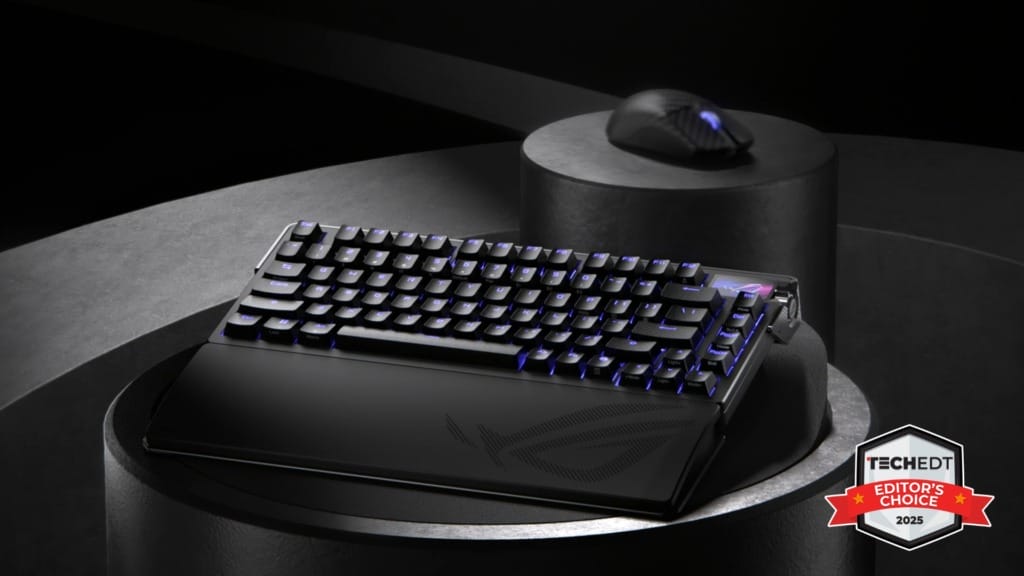

The ROG Azoth Extreme is a premium 75% gaming keyboard built for enthusiasts who want precision, customisation, and craftsmanship. With a full aluminium alloy chassis, carbon fibre positioning plate, and multiple gasket mount options, it delivers a refined typing experience that is both solid and responsive. A full-colour OLED touchscreen with a three-way control knob enables real-time monitoring and instant adjustments, while an extended wrist rest ensures comfort during extended sessions.
Tri-mode connectivity provides flexibility with SpeedNova 2.4 GHz wireless, Bluetooth support for multiple devices, and a wired USB connection. Pre-lubed hot-swappable ROG NX mechanical switches, sound-dampening foams, and customisable per-key lighting ensure the Azoth Extreme balances enthusiast-level quality with gaming performance.
Key features and benefits
- Premium build: Aluminium alloy chassis and carbon fibre plate for durability and acoustics.
- OLED touchscreen: Real-time info with a three-way control knob for adjustments.
- Tri-mode connectivity: SpeedNova wireless, Bluetooth, or wired USB options.
- Customisable typing: Hot-swappable ROG NX switches with gasket mount flexibility.
The best value pick gaming keyboard
NuPhy Field75 HE
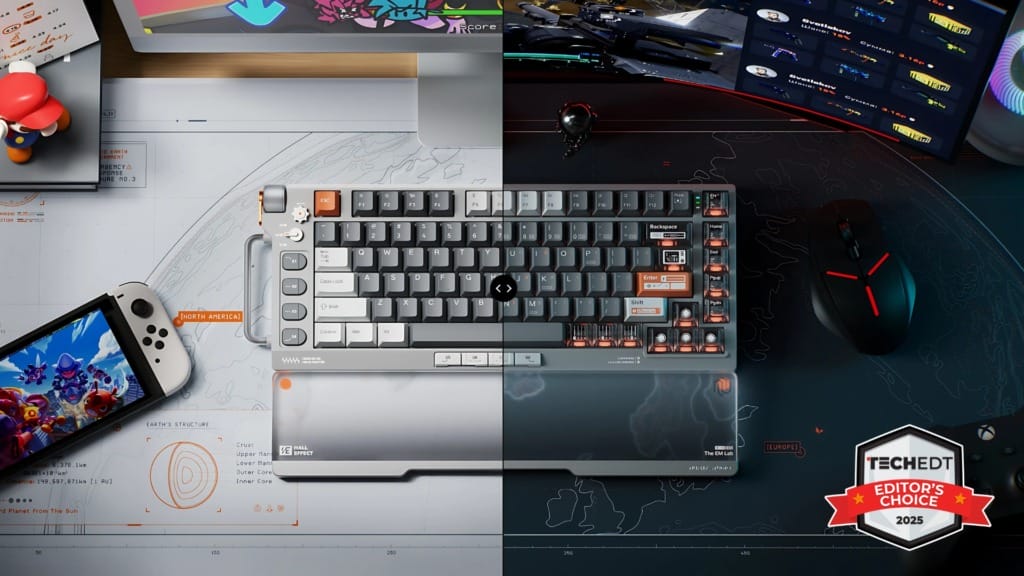

The NuPhy Field75 HE is a compact 75% keyboard that combines enthusiast-level craftsmanship with cutting-edge magnetic switch technology. Its Hall Effect switches allow for adjustable actuation and rapid trigger performance, providing competitive responsiveness. A robust aluminium build and sound-dampening layers deliver refined acoustics and smooth keystrokes.
With hot-swappable support, wireless and wired connectivity, and full RGB lighting, the Field75 HE adapts to both gaming and professional workflows. Its blend of performance, flexibility, and premium feel makes it a standout for users who want reliability with room for personalisation.
Key features and benefits
- Hall Effect switches: Adjustable actuation and rapid trigger technology.
- 75% layout: Compact design that saves desk space while retaining key functions.
- Customisable build: Hot-swappable switch support and refined stabilisers.
- Flexible connectivity: Bluetooth, 2.4 GHz wireless, and USB-C options.
ROG Strix Scope NX TKL
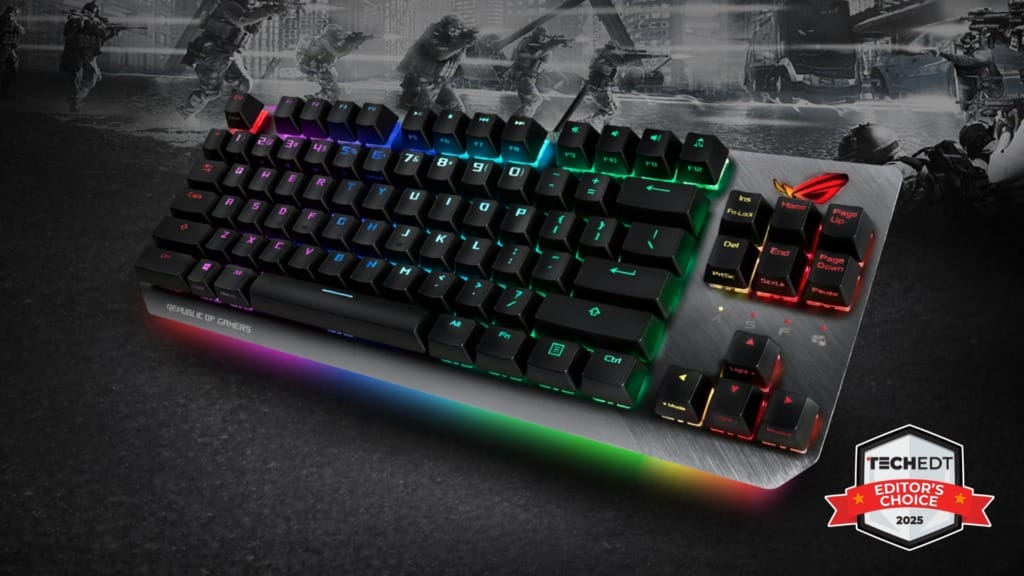

The ROG Strix Scope NX TKL is a wired mechanical keyboard designed for FPS players. Its tenkeyless layout frees up mouse space, while the enlarged left Ctrl key minimises accidental presses during high-pressure matches. With an aluminium top plate and Aura Sync RGB lighting, it combines durability with bold visual customisation.
Compact and travel-ready, the Scope NX TKL uses ROG-exclusive NX switches tuned for fast actuation and tactile feedback. It also features a detachable cable for enhanced portability, a Quick-Toggle switch for seamless media control, and a dedicated Stealth key for instant privacy.
Key features and benefits
- FPS-focused design: Enlarged left Ctrl key and TKL form factor.
- NX mechanical switches: Fast actuation with optimised force curves.
- Durable aluminium top: Strong build with Aura Sync RGB lighting.
- Portable and practical: Detachable cable, media toggle, and Stealth key.
MonsGeek FUN60 Ultra TMR
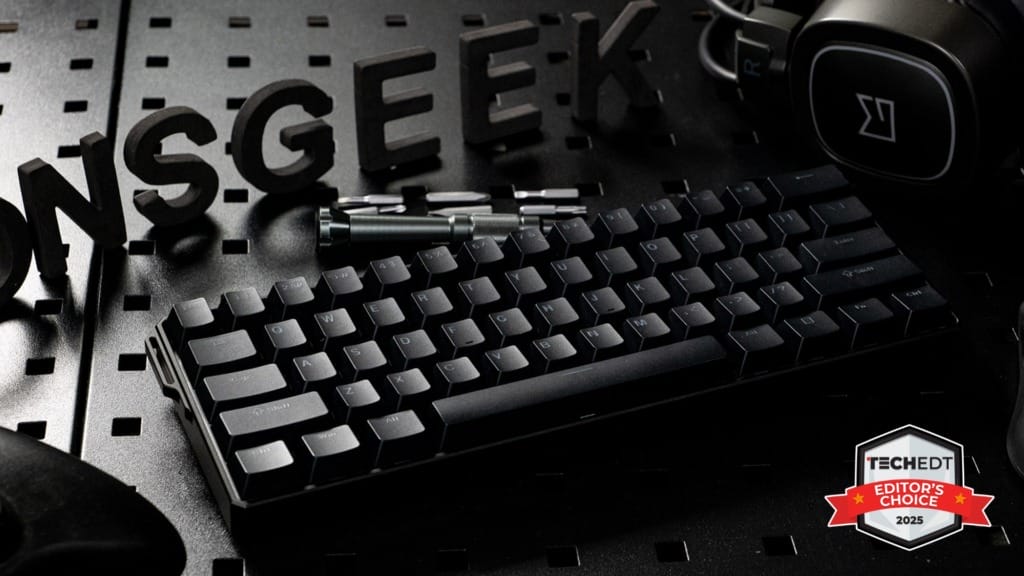

The MonsGeek FUN60 Ultra TMR is a compact 60% aluminium keyboard built for ultra-fast competitive performance. Featuring magnetic TMR switches with response times as low as 0.01 ms, it provides unrivalled speed while maintaining a sleek, premium frame.
Its flexibility sets it apart, offering cross-compatibility with major magnetic switches and hot-swappable support for 5-pin mechanical switches. With MagMech compatibility, the FUN60 blends the best of both magnetic and mechanical designs for a unique typing and gaming experience.
Key features and benefits
- Magnetic TMR switches: 0.01 ms response time for ultra-fast input.
- Compact 60% design: Space-saving aluminium build with a premium finish.
- Cross-compatible: Supports magnetic and 5-pin mechanical switches.
- MagMech support: Combines mechanical and magnetic switch technology.
SteelSeries Apex 3 TKL
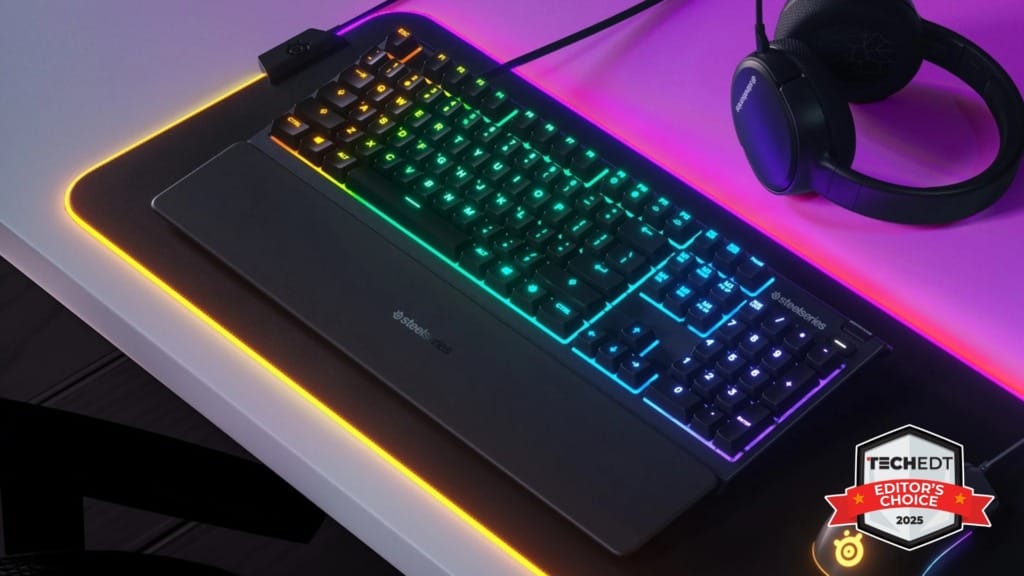

The SteelSeries Apex 3 TKL is a tenkeyless gaming keyboard built for quiet, durable performance at an affordable price. Its whisper-quiet switches are rated for 20 million keypresses, ensuring reliability for long-term use while providing a smooth typing feel. The compact design saves desk space, making it well-suited for esports or minimalist setups.
It also includes IP32 water resistance for protection against spills, dedicated media controls, and 8-zone RGB illumination that reacts to games and apps like Discord. Balancing durability with vibrant personalisation, it offers excellent everyday usability.
Key features and benefits
- Quiet, durable switches: Rated for 20 million keypresses.
- Compact TKL design: Saves space and supports esports play.
- RGB lighting: 8-zone customisable illumination with reactive effects.
- Water resistant: IP32 protection against accidental spills.
The best competitive gaming keyboard
Wooting 80HE
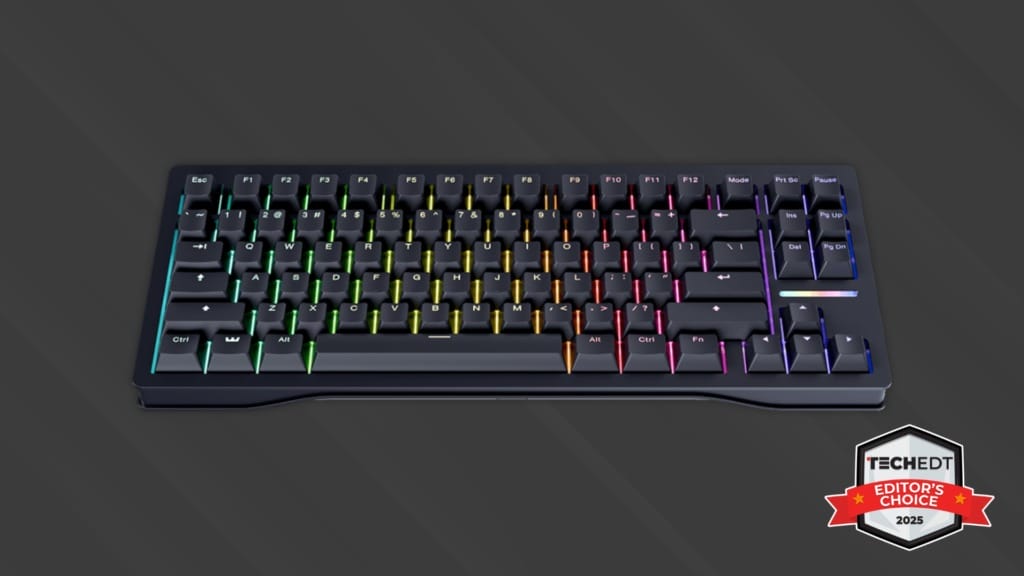

The Wooting 80HE is an 80% analogue keyboard designed for gamers who want precision, speed, and full customisation. Its Lekker magnetic Hall Effect switches provide adjustable actuation and rapid trigger functionality for near-instant responsiveness. The 80% layout strikes a balance between compactness and utility, retaining arrow keys and essential functions.
With support for 8,000 Hz polling, hot-swappable switches, and powerful software for fine-tuning, the Wooting 80HE provides an enthusiast-level experience for both competitive and casual players.
Key features and benefits
- Hall Effect switches: Adjustable actuation and rapid trigger support.
- 80% layout: Compact yet functional with essential keys.
- Ultra-low latency: Up to 8,000 Hz polling for instant responsiveness.
- Customisable build: Hot-swappable switches and advanced software.
Razer BlackWidow V4 X
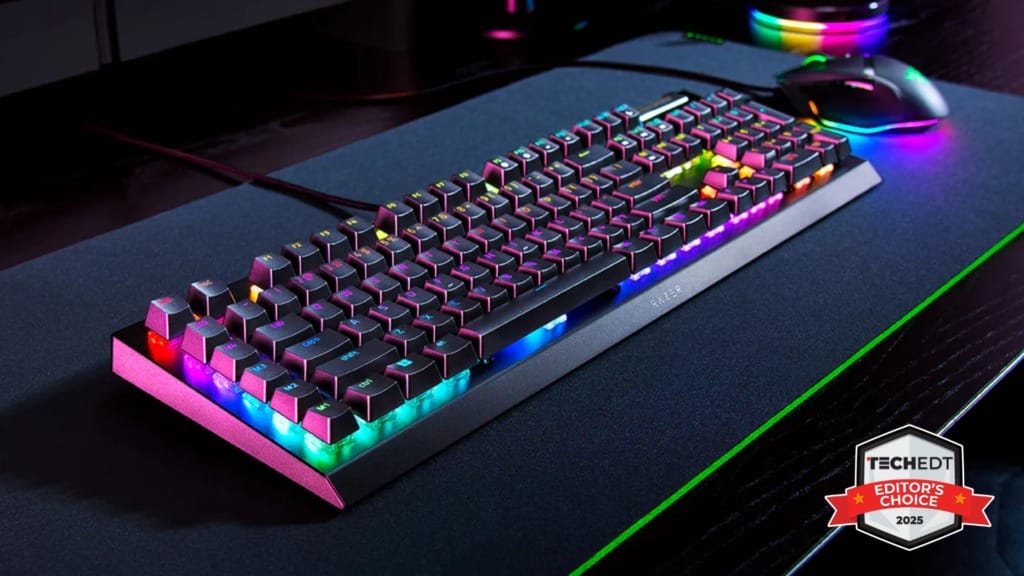

The Razer BlackWidow V4 X is a full-size mechanical gaming keyboard designed for players who need precision and convenience in one package. Featuring Razer’s mechanical switches, it delivers fast and responsive keystrokes, while dedicated macro keys and media controls ensure a streamlined gaming and productivity experience. Its aluminium top plate and per-key Chroma RGB lighting add both durability and visual flair.
Built for competitive play, the BlackWidow V4 X supports full key rollover and anti-ghosting for reliable input recognition during fast-paced sessions. It also includes a multifunction roller for media adjustments, making it equally useful for gaming marathons and everyday tasks.
Key features and benefits
- Razer mechanical switches: Fast, reliable actuation for gaming precision.
- Dedicated controls: Six macro keys and media roller for customisation and convenience.
- Durable design: Aluminium top plate with per-key Chroma RGB lighting.
- Reliable input: Full key rollover and anti-ghosting for accurate multi-key presses.
Logitech G515 LIGHTSPEED TKL
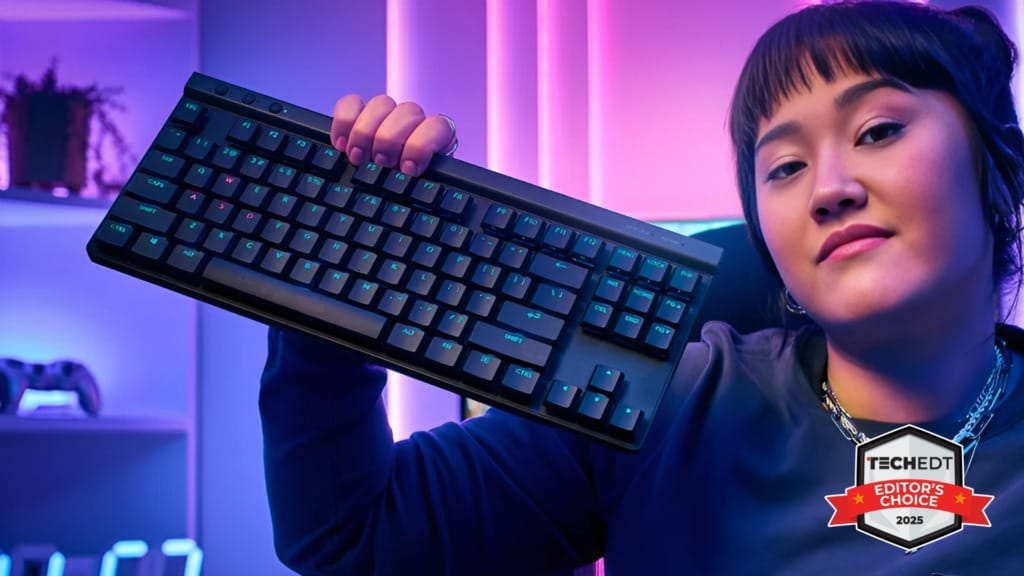

The Logitech G515 LIGHTSPEED TKL is a slim, tenkeyless wireless gaming keyboard designed to strike a balance between speed and portability. With low-profile mechanical switches offering fast actuation and precise input, it delivers a finely tuned typing experience in a compact and lightweight frame.
Equipped with LIGHTSPEED wireless for sub-1ms latency and Bluetooth support for multi-device use, the G515 ensures reliable connectivity. Its rechargeable battery provides up to 36 hours of playtime, making it a practical choice for competitive gamers who need consistent performance on the go.
Key features and benefits
- Low-profile mechanical switches: 1.3 mm actuation for fast, precise keystrokes.
- Wireless versatility: LIGHTSPEED sub-1ms latency and Bluetooth support.
- Compact TKL frame: Slim, portable design for space-saving setups.
- Strong battery life: Up to 36 hours on a single charge.
A new era of gaming keyboards built for speed, comfort, and personalisation
The latest generation of gaming keyboards highlights how far the category has come, evolving from simple input devices into highly specialised tools. With innovations in switch technology, connectivity, and design, players now have access to features that cater to both competitive performance and everyday use. Compact layouts, adjustable actuation, and wireless flexibility reflect a shift towards products that adapt to individual preferences rather than forcing a one-size-fits-all approach.
At the same time, durability, comfort, and style remain just as important as raw speed. Modern keyboards are expected to handle long hours of gaming while offering customisation options that allow each setup to feel unique. Whether for competitive play, creative work, or general productivity, the current range of keyboards demonstrates a clear focus on delivering versatility and refinement to suit the needs of a broad and demanding audience.
Technology
Why Healthcare Games Aren’t Just Child’s Play

At Nemours Children’s Health, Scott Shaw helps the health system’s young patients play games. He’s doing a lot more than just letting them have fun.
Health IT isn’t all fun and games. Until it is.
Scott Shaw has perhaps the most enviable tech job in healthcare. His job at Nemours Children’s Health in Wilmington, Delaware is to make sure all of the hospital’s pediatric patients can play video games – and to play with them if their family members and friends aren’t available.
“A lot of people go, ‘That seems like a dream job,'” the pediatric health system’s Game and Technology Specialist says. “And yeah, it is. I get to play video games with kids in the hospital while they’re here.”
“We have a lot of long-term kiddos,” he continues. “We have [children] that are here for repeated treatments and things like that. Getting to build relationships with those kids, doing something fun and normalizing … can distract them from what they’re going through and … connect them back to a community that they’ve already been taking a part in. That really helps to make the day go by a little easier.”
Serious Business
Fo Shaw and Nemours, playing is serious business – and it’s a strategy that healthcare leaders across the country should be considering. Video games as part of inpatient entertainment services promote patient engagement and satisfaction, helping both patients and their families get through the trying time of being in a hospital. In addition, innovative healthcare providers are using games and gaming technology to boost clinical outcomes, through specially designed games that tackle hot-button care gaps like chronic care management and medication adherence.
While it isn’t known how many health systems and hospitals actively support gaming or have programs in place, organizations like the Starlight Children’s Foundation and Child’s Play Charities work with children’s hospitals to help their patients access games. As of 2021, Starlight Gaming has helped more than 11.6 million children in more than 900 children’s hospitals in the U.S. and Puerto Rico, while Child’s Play is partnering with nearly 200 pediatric hospitals to integrate gaming and technology into pediatric patient care.
And that’s where Shaw comes in.
A former chair of the Game Design and Development Program at Wilmington University, he was brought into Nemours in 2022 through a two-year grant from Child’s Play. His work was so successful that Nemours made him a full-time staff member last year.
The 4 Pillars of Gaming at Nemours
Shaw’s work at Nemours is structured around four strategies:
Set up and maintain the gaming platform at the hospital and make sure all patients can access and play games. Shaw says he often gets surprised looks from patients and their parents when he walks into a room (he used to get surprised looks from the doctors and nurses as well, but he’s become a familiar figure now). And not just because he’s usually in a Hawaiian shirt.
“I have had parents, after I give my intro, explain what I do, they will immediately look at their kiddo and be like, there’s your dream job right there,” he says.
Aside from introducing patients and their parents to the gaming platform, he’s in the background, making sure everything is working properly and the kids have access to age-appropriate games.
Play games with patients who need gaming partners. This is an undervalued responsibility. Parents and siblings usually can’t stay in the room forever, and the toughest time for kids is when they’re alone in the hospital room. That’s when Shaw steps in.
“If you don’t have a buddy, if mom or dad or your brother or sister aren’t here and you need somebody to play with, just tell your nurse and I’ll come and hang out for a little while and we can either talk about gaming or play some games,” he tells the kids.
That goes a long way toward making someone feel a little bit more comfortable at a very trying time.
Help develop programs that use games to improve care management. This is where Shaw’s job intersects with clinical care. Aside from entertainment, these games can help kids better understand their care, or get them through a tough time. Shaw says he’s helped kids during a stressful wound dressing change by putting them on a VR set that has them interact with kittens, or on a roller coaster ride timed perfectly to end with the dressing change.
Shaw also develops games that can help kids stuck in their rooms explore the hospital campus, or go to places they would have gone on vacation with their families had they not had to go to the hospital.
They’re merging gaming tech and patient care to “help kids feel normal again [and] distract them from what they’re going through,” he says. Most importantly, “when they need it, [he can] be the support system throughout the hospital for kids.”
Help develop special projects that merge gaming with patient care.
These are the clinical games – games that help children diagnosed with diabetes to understand their chronic condition and how to care for themselves, or games that explain cancer or asthma or heart disease. These can be better tools than any doctor’s printout or tutorial.
This is where gaming, games and gaming theory hold the most potential in healthcare. They can be used to help not only children, but patients of all ages understand what they’re going through and teach them how to manage their care and live healthier lives. They’re tools that can unlock not only better engagement and adherence, but also better clinical outcomes.
“I think we’re going to get to that point where a lot more folks are looking at it seriously and going, ‘This is where we need to be,'” says Shaw.
Understanding Why Games Are Played
One important aspect about gaming at Nemours, Shaw says, is that it’s not based on the idea of getting a reward for completing a task successfully.
“Making you better is not a reward,” he points out. “This is what we do. We want to enable that.”
Games, he says, are for entertainment and learning, not winning prizes. To that end, it can be fun to lose a game and see what happens, and to be able to play it again with a different outcome.
The Clubhouse
Shaw works often from The Clubhouse, a third floor haven in the health system that encompasses activities and arts and crafts organized by activity coordinators and child life specialists, a preschool area and dramatic play area, a teen area with an air hockey table, pool table and the aforementioned gaming systems, and even a CCTV studio (he says Bingo on Wednesdays is very popular).
It’s a very different atmosphere in there, compared to the rest of the hospital. That, given the very nature of a pediatric hospital, makes it a special place.
“If we’re out here at The Clubhouse and we’re playing [games], you’ll hear lots of laughter, lots of hooting and hollering and giggles,” he says. “And to hear that within a hospital, I know I’m doing something right. If we’re bringing smiles or bringing laughter, families are having fun, kids are having fun, siblings are having fun. … That is the best indicator that I think it’s working.”
Shaw, who networks often on a Slack channel for fellow pediatric gaming specialists and attends symposiums on gaming in healthcare, says the network isn’t big enough by far. When asked what most surprises him about the use of games in healthcare, his response is, ‘Why doesn’t every hospital have a me?’
This should be an integral part of any health system, he says, helping adults as much and as often as children. Every hospital IT platform should encompass games and gaming, and every hospital should have gaming specialists.
“I would love to take this up and down the care spectrums to really see what kind of impacts we can make using gaming,” he says. “It would be a lot of fun.”
Much more than just fun.
Eric Wicklund is the associate content manager and senior editor for Innovation at HealthLeaders.
Technology
Skin Gambling in Finland Fuels Esports Wagering Growth

Finland is witnessing a major shift in its gambling culture as skin gambling and esports betting take center stage. The skin gambling Finland offers (or skin gambling in general) refers to the use of in-game cosmetic items, often called skins, as a form of currency to place wagers on competitive gaming matches.
This new wave of wagering has captured attention across the country, aligning with Finland’s long-standing gambling traditions while introducing digital-first experiences that speak to a younger audience.
The rapid expansion of esports betting in Finland is no coincidence.
As competitive titles like Counter-Strike 2 and League of Legends attract dedicated fan bases, Finnish gamblers are embracing innovative platforms that let them blend entertainment with wagering opportunities. Market growth is accelerating, and the upcoming regulatory overhaul in 2026 is set to transform this sector even further.
Understanding these changes offers valuable insight into how gaming and gambling are converging, why it matters now, and what it signals for the esports wagering in Europe will have in the future.
Trends for Skin Gambling in Finland
Skin gambling in Finland is emerging as a cultural and economic force, reshaping how bettors interact with both esports and gambling markets.
The practice, rooted in trading cosmetic in-game items for wagering purposes, has grown into a sizable activity across Europe, and Finland is at the forefront of its expansion. With gambling deeply ingrained in Finnish society, the transition toward digital betting models has been seamless.
Esports audiences are already accustomed to valuing skins in their favorite games, making the jump into wagering both natural and attractive. This growth represents more than a passing trend; it reflects the way Finns are redefining entertainment, combining their appetite for competition with financial stakes.
The sharp rise in activity can be traced to several factors: the popularity of competitive titles, the increased visibility of esports through streaming, and the country’s broader enthusiasm for gambling in general.
Together, these factors have created fertile ground for skin-based betting to thrive.
Expanding Market Interest
Interest in esports betting in Finland has increased rapidly among younger demographics. Players who once viewed skins solely as cosmetic enhancements now recognize their monetary value and potential as a form of wagering assets.
Finnish operators are taking note by integrating esports markets into their offerings, catering to a digitally savvy generation eager for immersive betting experiences. The momentum suggests that skin gambling is not an isolated niche, but rather, is part of a broader shift in how people engage with online wagering.
Skin Gambling Finland: Why It Matters Now
The significance of skin gambling in Finland lies in timing and cultural alignment. Gambling participation in the country has traditionally been high, with surveys indicating that a large share of the population engages in some form of wagering.
Introducing esports into this ecosystem has allowed operators to connect with audiences who value interactive, tech-driven experiences. The rise of CS:GO skin gambling, in particular, demonstrates how virtual items once dismissed as simple collectibles can evolve into powerful drivers of market growth.
Influence of Finnish Gambling Trends
Finnish gambling trends highlight the convergence of tradition and innovation. The market is shifting from state-controlled structures to open, competitive models, and this transition is driving the emergence of new forms of play.
Skin gambling aligns with these trends by offering a contemporary way to participate in a long-standing national pastime.
As regulations evolve and consumer behaviors adapt, Finland’s esports betting landscape is positioned to set a precedent for how digital wagering can integrate with established gambling cultures.
Why Is Esports Betting in Finland Important?
The esports betting Finland offers has quickly evolved from a niche interest into a significant cultural and economic phenomenon. Understanding why this matters provides clarity on how gambling traditions are adapting to modern audiences and why the industry is preparing for transformation.
The growth of esports wagering reflects Finland’s passion for gaming while simultaneously signaling broader changes in digital entertainment and gambling markets.
Role of Streaming and Emerging Technologies
Streaming platforms like Twitch, YouTube, and Facebook Gaming have transformed esports into a live spectator experience that resembles traditional sports broadcasting.
Viewers are no longer confined to watching local events or highlight reels. Instead, they can follow competitions in real time, access expert commentary, and connect with other fans while simultaneously exploring betting opportunities.
For Finnish audiences, this integration between viewing and wagering has heightened engagement. Utilizing Counter-Strike 2 gambling sites as part of a skin gambling match or a League of Legends tournament becomes more immersive when fans can place wagers that align with their viewing interests.
The accessibility of streaming services has broadened esports’ reach, ensuring that casual viewers and dedicated fans alike can participate in skin gambling in Finland without barriers of geography or scheduling.
Emerging technologies, such as virtual reality (VR), augmented reality (AR), and artificial intelligence (AI), are further enhancing this landscape.
VR and AR provide bettors with immersive environments that allow them to visualize data, statistics, and live action in interactive formats. AI-driven analytics provide personalized insights that enable users to refine their strategies, offering tailored recommendations based on past behavior and betting patterns.
These technologies create richer experiences while also introducing complex ethical considerations. As personalization increases, regulators and operators face questions about data use, responsible gaming practices, and the fine line between entertainment and exploitation.
Other Considerations
Esports betting in Finland does not exist in isolation. It operates within a framework of upcoming regulatory change, international pressures, and ethical responsibilities. These elements shape the trajectory of the industry and determine how sustainable growth will be managed.
Regulatory Shifts in 2026
Finland is preparing to liberalize its gambling market in 2026, marking a pivotal moment for the industry. The shift will end the long-standing state monopoly and introduce a licensing system for foreign competitors. This change will open doors for international operators to enter the Finnish market, sparking competition and innovation.
The 2026 reforms are more than a procedural adjustment. They represent a redefinition of how gambling is governed in Finland.
Licensing ensures that operators meet compliance standards, while new consumer protections aim to safeguard players. Authorities are also considering restrictions on marketing, particularly to limit exposure among young audiences.
When to comes to players who frequent the esports betting websites, this transition can create new opportunities for growth while demanding greater responsibility from operators.
International Regulatory Pressure and Youth Concerns
Global investigations into skin betting practices have revealed challenges that extend beyond Finland’s borders. Reports show that ads promoting skin gambling often appear across major platforms like Facebook, Google, YouTube, and Twitch without sufficient age verification. This lack of oversight creates risks of exposing minors to gambling promotions.
In Finland, skin gambling sites frequently operate under classifications that treat skins as prizes of monetary value rather than traditional gambling currency. This distinction enables platforms to circumvent existing regulations, leaving regulators with the task of updating definitions to reflect new realities.
International scrutiny has intensified the call for more straightforward guidelines, and Finland’s regulatory overhaul provides an opportunity to address these concerns directly.
Ethical and Legal Risks
The ethical and legal challenges associated with esports betting in Finland are multifaceted. The first issue lies in underage access, as digital platforms make it easier for young audiences to interact with gambling mechanics. Without robust safeguards, there is a risk of normalizing wagering behavior among minors.
Another unresolved dilemma is the status of skins as a legitimate currency. While players assign real-world value to these items, legal frameworks often struggle to categorize them. This creates a gray area where skins are treated as both commodities and gambling assets, complicating oversight.
Advertising practices further highlight the need for regulation. The placement of betting promotions during esports streams raises questions about responsibility and the potential for exposure. In a market as engaged and youthful as Finland’s, operators face heightened scrutiny to ensure that growth does not come at the expense of ethical standards.
Addressing these issues proactively will be essential to maintaining public trust and ensuring long-term stability in the industry.
Global and Local Context of Skin Gambling
The rise of skin gambling Finland cannot be fully understood without considering how the practice has developed worldwide. From its origins in gaming communities to its adoption as a mainstream form of wagering, skin gambling has expanded into a complex market with both economic and cultural significance.
Within Finland, these global influences are shaping local dynamics, aligning with national gambling traditions and regulatory changes.
Understanding Skin Gambling Worldwide
Skin gambling is the practice of using cosmetic in-game items, known as skins, as currency for wagering on esports events or games of chance. These items hold real-world value due to their scarcity, desirability, and role in shaping player identity within online communities.
While skins were initially designed as visual enhancements, they quickly evolved into digital assets that could be traded or staked in betting scenarios.
Internationally, the popularity of skin gambling accelerated during the mid-2010s, particularly in connection with Counter-Strike: Global Offensive (CS:GO). Industry estimates suggested that by 2016, the global skin gambling market had reached approximately $5 billion in activity.
That surge underscored the growing financial power of digital commodities and the demand for alternative wagering formats. If left unchecked, experts projected even greater expansion in subsequent years, positioning skin gambling as a central feature of esports betting markets worldwide.
The global trajectory also revealed key challenges. Regulators struggled to define skins within existing gambling laws, and concerns about underage participation became widespread.
Despite these issues, the appetite for wagering with digital items remained strong. For Finland, this international context presents both a blueprint for growth and a cautionary tale about the risks associated with rapid expansion.
CS:GO Skins Gambling and Other Leading Titles
Within Finland, CS:GO skins gambling has become a focal point of esports betting.
Counter-Strike 2, the successor to CS:GO, continues to attract massive audiences and a vibrant community of traders who view skins as valuable assets. These digital items are frequently used as stakes in wagers, blending the thrill of competitive play with the tangible sense of financial risk and reward.
League of Legends also holds a prominent position in Finnish esports betting. While skins in League function differently from those in Counter-Strike, the game’s competitive ecosystem ensures that it remains a primary driver of wagering interest.
Together, these titles represent the backbone of Finland’s esports betting market, with their influence extending beyond gameplay into the financial and cultural spheres.
The popularity of these games illustrates how skin gambling in Finland has capitalized on established communities. Players already invested in acquiring and showcasing skins find it natural to use them in scenarios on their favorite betting sites.
The integration of these mechanics into mainstream esports events has only deepened engagement, drawing in both experienced bettors and newcomers who are eager to explore digital wagering.
Cultural and Market Dynamics
Finnish gambling trends provide a unique backdrop for an esports betting boom. With approximately 80 percent of Finns participating in some form of gambling, the nation has long incorporated wagering into its cultural fabric.
This environment has made the adoption of esports betting remarkably smooth, as digital forms of gambling align with existing habits while introducing new opportunities for engagement.
Online casinos have recognized this momentum and are adapting their platforms to include esports markets. By doing so, they meet the demand of younger, tech-savvy users who value interactive experiences.
The move represents a diversification of offerings as much as it does a strategic alignment with shifting consumer behavior. As more Finns seek digital-first entertainment, esports betting emerges as a logical extension of traditional gambling practices.
The cultural acceptance of gambling also plays a role in legitimizing skin wagering. Unlike in markets where gambling carries a social stigma, Finland’s openness has allowed esports betting to gain traction without resistance.
This acceptance has created fertile ground for innovation, with operators experimenting with ways to seamlessly merge competitive gaming and wagering. By bridging global developments with local traditions, Finland stands out as a country where skin gambling is not merely an imported trend but a practice uniquely suited to its gambling culture.
The combination of international popularity, leading titles, and cultural alignment ensures that esports betting Finland will remain an area of significant growth and attention in the years ahead.
What Do Finnish Gambling Trends Mean for Gamers?
Understanding Finnish gambling trends helps reveal how esports betting is shaping the experience of gamers.
The growth of skin gambling Finland does not simply add another wagering option. It is reshaping how communities interact with their favorite games, how operators design their platforms, and how the broader digital entertainment culture evolves.
For players, these changes bring new opportunities to engage with esports while also highlighting the importance of understanding the market’s trajectory.
The Demographics Fueling Finland’s Boom
The demographic profile of esports betting Finland is central to understanding its rapid growth.
Research indicates that the majority of bettors fall within the 18 to 43 age bracket, accounting for roughly 87 percent of the market in 2024. Within this group, millennials stand out, representing nearly half of the participants.
This generation, raised on video gaming, is now driving demand for digital wagering experiences that feel familiar, interactive, and community-oriented.
Young adults in Finland are particularly receptive to the integration of skins into betting. Many have grown up treating these items as valuable digital assets, whether collected in Counter-Strike or earned while betting on League of Legends. Using them as currency in wagers feels like a natural extension of their gaming history.
This comfort with digital value systems underscores why skin gambling has resonated so strongly in the Finnish market.
For operators, these demographics represent a prime opportunity. By tailoring platforms to younger users, companies can ensure sustained growth in a market that is already highly engaged.
For gamers, the demographic trends suggest that esports betting will continue to reflect the values and behaviors of their peers, reinforcing a sense of belonging within the community.
The Future of Finland’s Online Gambling Market
Finland’s online gambling market is robust and growing. As of 2025, the industry generated an estimated gross gaming revenue of around US$1.31 billion. User penetration has reached approximately 20.6 percent, highlighting how widely digital gambling has been embraced across the country.
On an individual level, the average revenue per user is roughly US$1,150, underscoring the financial weight of each participant.
These figures illustrate the scale of engagement and the depth of Finland’s digital gambling ecosystem. For gamers, this means that esports betting is not a marginal activity but a mainstream feature of the market. Platforms are investing heavily in esports offerings, and operators are increasingly willing to adapt their services to meet the demands of this audience.
The upcoming 2026 regulatory reforms are expected to amplify this momentum. With the introduction of licensed competition, Finnish users can expect a greater variety of options, improved safeguards, and more competitive products. For gamers, the reforms represent an opportunity to engage in esports betting within a more transparent and structured environment.
This evolution will likely enhance trust in the industry while ensuring that growth is aligned with responsible practices.
Opportunities for Finnish Gamers
The expansion of esports betting in Finland creates meaningful opportunities for gamers. One of the most significant is the ability to merge entertainment with financial stakes in a way that reflects modern digital lifestyles.
Watching a live Counter-Strike 2 match becomes more engaging when bettors can use skins to back their predictions. This combination of viewing and wagering builds deeper connections between fans and the games they follow.
Another opportunity lies in the innovation of betting platforms.
As operators compete for attention in the new regulatory landscape, gamers can expect fresh features, personalized recommendations, and more immersive experiences powered by VR, AR, and AI. These advancements will not only improve usability but also ensure that esports betting feels dynamic and responsive to individual preferences.
The cultural acceptance of gambling in Finland also enhances the opportunities for gamers. Unlike in markets where gambling carries negative associations, Finnish players can engage without stigma.
This openness supports a thriving community where esports betting is viewed as part of the broader entertainment ecosystem, further enriching the experience of participation.
Why Finnish Gambling Trends Signal a Bright Future
The trends shaping esports betting in Finland indicate a promising and sustainable future for gamers.
Demographic alignment ensures a steady base of engaged users, market size provides a solid foundation for continued growth, and regulatory reforms are paving the way for innovation and consumer protection. Together, these elements create a landscape where esports betting can thrive while providing meaningful value to participants.
For gamers, the implications are clear. Esports betting is poised to become an increasingly integrated part of their digital lives, offering opportunities for entertainment, community, and financial engagement.
While challenges remain in areas such as regulation and ethics, the momentum behind skin gambling suggests that the practice will only grow stronger in the coming years.
The Future of Esports Wagering Europe
The rise of skin gambling in Finland illustrates how rapidly digital gambling can evolve when cultural acceptance, technological innovation, and regulatory change intersect. What began as a niche practice of trading in-game items has evolved into a market segment reshaping how Finns interact with their favorite esports titles.
As Finland prepares to open its gambling market in 2026, the stage is set for esports betting to become a more central component of the country’s gaming culture.
The implications extend far beyond Finland’s borders. Europe is closely watching how the country manages its transition to a competitive licensing model, particularly as esports betting becomes more mainstream.
Success in this area could influence how other markets regulate skin wagering, while also highlighting Finland as a leader in striking a balance between innovation and consumer protection. For gamers, the changes signal opportunities to engage with esports in more interactive, personalized, and rewarding ways.
Finnish gambling trends suggest that esports betting is not merely a temporary surge, but rather part of a larger shift in entertainment. With strong demographics, a tech-savvy population, and a history of embracing gambling, Finland is well-positioned to drive the future of esports wagering Europe has to offer.
For readers, the message is clear. The convergence of gaming and gambling is accelerating, and Finland is emerging as a focal point in that evolution. As the market grows and regulations adapt, staying informed will be essential.
Keep your eyes on future updates, because the story of skin gambling in Finland is still unfolding and promises to shape the next chapter of digital wagering.
Technology
Vindral leaders explain how it can help

In this guest column, Vindral’s founder Niclas Åström and chief executive officer Daniel Alinder share their view on using artificial intelligence to enhance, not overwhelm, the live gaming experience.
Artificial Intelligence is everywhere. In the last 18 months, it has dominated headlines, boardroom conversations, and product roadmaps across industries. In iGaming, as in other sectors, everyone wants to know where AI fits in; what’s hype, what’s possible, and what’s worth the investment?
Live casino adds its own layer of complexity to that discussion. For much of its history, the category has been dominated by authentic, physical studio setups. The combination of real dealers, real equipment, and carefully designed environments has been central to building trust and credibility with players.
That has shaped the common perception that “live” should mean untouched by too much digital input. Players come to live roulette, blackjack, or baccarat for the human connection and the sense of fairness that physical setups provide.
It is a valid point of view, but it also comes with limitations. Physical-only setups take up more space, cost more to build, and are harder to modify or scale. They also leave less room for game format innovation.
The arrival of AI, when combined with technologies like green screen, is changing that equation. It opens up new creative and operational possibilities for studios. The challenge is knowing where to draw the line.
Getting AI wrong in live casino
If AI is applied without thought, it can quickly undermine the player experience. We have all seen examples in other forms of entertainment where digital overlays are overdone or thematically misplaced. In live casino, the equivalent would be inserting your roulette table into a cartoon landscape or a surreal backdrop. That might be visually striking, but it takes the player’s focus away from the game, and the game is what they are there for.
Take roulette as an example. Players want to see two things: the wheel and, perhaps, the dealer. They want the play to feel authentic and the interface to help them follow the action without distraction. That is why at Vindral we advocate for a balanced approach. Use AI to enhance, not to overwhelm. Use it to make the game more engaging and easier to follow, not to turn it into something unrecognisable.
Turning a simple idea, into a game changer
That philosophy guided the development of our roulette wheel tracker. The idea came when working with one of our more progressive and innovative clients. They wanted to create a cleaner, more intuitive version of the popular multiplier roulette format.
Multiplier roulettes are incredibly popular but, in their standard form, can be cognitively tiring for players over longer sessions. In most versions, you have to watch several areas of the screen to see which numbers have been given multipliers. That creates a disjointed viewing experience, where attention is split between the wheel, the dealer, and the digital interface.
Our client’s suggestion was simple but clever: what if the multipliers appeared directly on the wheel? This would keep the player’s focus on the physical game, increase anticipation, and make it easier to follow over time.
Working with them, it became clear that our existing strengths in streaming through Vindral Live, and real-time video compositing via Vindral Composer, could make this possible. By combining those capabilities with AI algorithms and computer vision, we developed a system that can recognise roulette numbers in real time and apply perfectly aligned overlays as the wheel spins.
The result was V-Track Roulette, launched in summer 2024. It has been in continuous use since then without a single glitch. For operators, it provides a fresh take on a proven game type. For players, it makes the experience more immersive without compromising the authenticity of the game.
Extending the concept
Once you know how to track a roulette wheel with precision, the natural next step is to apply that to other game formats.
Money wheel game shows are a prime candidate. They are popular across multiple markets but, in most cases, the design is static: the wheel always has the same number of segments, and the presentation rarely changes.
Our V-Track Money Wheel solution also leverages AI-powered computer vision, but works with a much larger, more versatile canvas. By accurately tracking the wheel’s movement and recognising its segments, we can enable dynamic overlays like multipliers, bonus symbols, or even entirely new gameplay elements that appear to be part of the physical wheel.
This opens the door to more creative, flexible game show formats that still look and feel “live” but have greater potential for variation and innovation. For operators, it is a way to differentiate without having to redesign or rebuild physical wheels, while also enabling multi-branding, meaning a single setup can power multiple brands and experiences.
The overlooked value of AI in audio
Visual enhancements get most of the attention, but in live casino, audio is equally important. Poor sound quality can undermine even the best-looking production. Background noise, echo, or uneven dealer audio can break immersion and shorten player sessions.
Crystal Speech, our AI-based voice enhancement tool, tackles this head-on by removing unwanted noise; anything from air conditioning to card shufflers and chatter from nearby tables.
From a production point of view, this has major implications. Studios can place tables closer together and build game show rooms with less acoustic insulation. That reduces construction costs and allows more games to run within the same footprint. In a sector where studio space is expensive and expansion can be logistically challenging, this is a significant operational benefit.
Choosing the right AI projects
For us, the decision to develop an AI feature comes down to one question: does it add real business value?
That value can take several forms. It might enhance the player experience, as with V-Track Roulette. It might solve an operational challenge, as with Crystal Speech. Ideally, it will do both.
We are not interested in AI features that are technically impressive but have no clear application. In live casino, novelty wears off quickly. Features have to deliver measurable benefits, whether in engagement, retention, or efficiency, to justify their place in a product roadmap.
What’s next for AI in live gaming
Looking ahead, we see two key areas where AI can make a difference. The first is in further expanding the V-Track Money Wheel’s capabilities, giving studios even more creative flexibility for wheel-based game shows.
The second is in game integrity and risk (GIR) operations. AI has enormous potential to make these functions more efficient and reliable, from automating parts of fraud detection to streamlining compliance monitoring. The same applies to support functions, where AI can speed up response times and help resolve player issues more effectively.
In both cases, the guiding principle is the same as it has been for our existing features: use AI to solve real problems and make the live gaming experience better for everyone involved.
Finding AI’s “killer app” in live casino
The hype around AI will continue, and so will the experimentation. Many ideas will be tried. Some will fade quickly – others will become industry standards.
In our view, the “killer app” for AI in live casino will be the one that balances authenticity with enhancement. Players still want to feel that they are in a real casino, interacting with real people. The role of AI should be to make that experience smoother, more exciting, and more accessible, not to replace it with something entirely virtual.
V-Track Roulette and V-Track Money Wheel, along with Crystal Speech are all examples of how AI can add value without breaking the core contract between player and game. They do not just look good on a features list. They make games easier to follow, more immersive to play, and more efficient to produce.
That is where we believe the true potential of AI lies in live gaming – where technology, creativity and operational reality meet.
Technology
Why operators need to adapt or risk fading away — GR8 Tech

Legacy technology is already slowing operators down – and in a marketplace set to become even more competitive, the risks of standing still are only growing. GR8 Tech CEO Alex Feshchenko argues that decisive investment in adaptable platforms is the only way for iGaming businesses to secure their future.
The gambling industry is grappling with a challenge that threatens its growth: outdated technology.
Across casinos and sportsbooks, legacy systems still underpin operations, from player accounts to betting markets. Once the backbone of stability, these platforms are now a drag on progress, trapping operators in costly maintenance cycles and limiting innovation. Just recently, iGB pondered whether the industry has actually lost its taste for cutting-edge technologies.
While some businesses continue to survive in 2025 with patched-up infrastructures, the days of clinging to the past are numbered. As competition intensifies, operators unable to capitalise on new technological developments – particularly amid the AI revolution – risk being left behind.
The migration dilemma
Replacing legacy technology is not a decision made lightly. Migration is complex and time-consuming, demanding total focus and carrying the risk of player disruption or revenue loss. Wary of these consequences, many operators postpone the move indefinitely, stitching together ‘Frankenstein’ systems from multiple providers and in-house fixes. The result is clunky platforms that are expensive to maintain and difficult to enhance, ultimately slowing business growth.
This reluctance highlights an irony at the heart of the gambling industry: a sector built on risk is often risk-averse when it comes to gambling technology. Operators who cling to legacy systems may preserve short-term stability but sacrifice long-term opportunity.
Alex Feshchenko, chief executive officer at GR8 Tech, understands the challenge better than most. Having once been the executive holding a metaphorical finger over the red button of migration, he knows the weight of the decision – and the fear that accompanies it.
Ultimately, however, he argues that the real danger lies in standing still.
“The biggest problem with legacy systems is it’s very difficult to turn them off,” Feshchenko said. “Five years ago, I was personally the guy responsible for migration to the new platform.
“It was a really hard decision to make. We spent perhaps more than a year to make things as smooth as possible as we migrated all the clients from the legacy platform to the new one.

“The hardest thing in this story is that you must make the choice and then be really focused on following it through. The danger is that you can spend years and years trying to make it as soft as possible without losing any player, just closing all the features.
“Unfortunately, many operators on the market are struggling and they are afraid of taking this necessary step.”
Enter the tech, entertainment giants
If standing still is dangerous, the road ahead is even more unforgiving. Competition in gambling has the potential to intensify beyond recognition, as the industry is no longer fighting only itself. Global entertainment and technology giants have been showing an increasing interest in the sector as the expansion of regulated betting markets becomes ever more appealing. Disney’s launch of ESPN Bet marked one of the world’s biggest entertainment brands embracing the fast-growing online gambling market, with former CEO Bob Chapek describing sports betting as “a very significant opportunity for the company – and it’s all driven by the consumer.” Meanwhile, tech giant Amazon now integrates betting content within its National Football League (NFL) broadcasts and Meta, Google and Apple all allow gambling apps in their stores.
With their unmatched scale, global audiences and world-class digital ecosystems, these giants are positioned to redefine customer expectations overnight. For today’s operators, the warning is clear: without decisive investment in flexible, competitive technology, they risk being overwhelmed not just by traditional rivals, but by some of the most powerful consumer brands on the planet.
“Sooner or later the big players will come in,” said Feshchenko. “We already see giants like Disney moving into regulated US markets, and I expect technology giants will follow.
“The future will bring tougher competition, consolidation, and a harder fight for key talent. The companies investing now in technology and people will be the ones winning long term, while those chasing short-term success may struggle without the fundamentals.”
Meeting this increasingly competitive challenge requires more than incremental upgrades. Operators need platforms that are not only fast and reliable but also extensible and adaptable – technology that can scale to meet surging demand, integrate seamlessly with existing operations, and deliver the personalised experiences that consumers now take for granted. This is precisely where GR8 Tech’s Platform for Champions positions itself as a genuine differentiator.
The platform includes innovations such as the ultra-fast ULTIM8 Sportsbook iFrame and the fully loaded Hyper Turnkey, but it is the platform’s extendibility that truly sets it apart. Originally built to fuel growth at established B2C gambling brands generating millions in gross gaming revenue, it has been engineered with adaptability in mind. These operators know their markets, products and audiences better than anyone; GR8 Tech’s job is to give them the freedom to modify, enhance and tailor the platform in ways that deliver competitive advantage.
“This isn’t an off-the-shelf product,” Feshchenko explained. “Our clients extend it, integrate it, and push it in ways that maximise flexibility and performance. Leading operators have already proven how far the platform can go.”
Pursuing personalisation
That same adaptability underpins another crucial dimension: personalisation. In an environment where tech giants and entertainment companies already excel at tailoring content to individual users, gambling operators cannot afford to lag behind. AI-driven personalisation has long been hailed as the next frontier in sports betting and gaming, and GR8 Tech has been investing heavily in this area for years. Rather than forcing players to scroll endlessly through static menus, its system presents tailored recommendations, challenges and promotions that make each user feel recognised and understood.
The results are tangible. According to GR8 Tech, customised player journeys and real-time personalisation can increase engagement rates by as much as 30%, while churn prediction achieves 80% accuracy. This level of insight and responsiveness is not simply a nice-to-have — it is fast becoming a prerequisite in a market where consumers expect the same level of relevance and immediacy they experience on streaming or e-commerce platforms.
“The gambling industry has often looked to entertainment and e-commerce for inspiration,” Feshchenko said. “But by making personalisation a priority, we believe gambling technology can finally step up as a trendsetter rather than a follower. Just like Netflix or Amazon, after a few bets a player should already have a unique product. That’s how we fight for attention.”

A champion mindset
Technology is not the only obstacle operators must overcome. Regulatory headwinds – from complex compliance frameworks to shifting tax burdens – remain an unavoidable reality across global markets. These pressures can feel like a constraint on growth and make technological advancements more complex and expensive.
However, GR8 Tech believes that such challenges should instead be seen as a proving ground for champions. Success in such an environment requires not only robust platforms but also a resilient mindset.
That is why GR8 Tech developed the Heavyweight Club concept in partnership with Ready to Fight – a platform co-founded by the World Heavyweight champion boxer Oleksandr Usyk. Inspired by the Ukrainian fighter’s discipline and mental toughness, the initiative fosters a community of ambitious, performance-driven operators who scale smart, act fast and play to win. In a market where regulation can change overnight, hesitation is costly. As GR8 Tech notes, champion heavyweights move with purpose – seizing opportunities, adapting strategies under pressure and maintaining focus on long-term performance.
“This business model is built on collaboration, and if both sides bring the right ingredients, we can achieve long-term success together”
“Only strong teams can succeed in today’s competitive market, and we are looking for exactly those kinds of partners,” Feshchenko added. “Success comes from true cooperation – when the scale and strength of our platform combine with the size, expertise, and market knowledge of the operator. That’s the recipe for a winning case and a lasting partnership.
“This business model is built on collaboration, and if both sides bring the right ingredients, we can achieve long-term success together.”
The decisive choice
In an industry where hesitation can be costlier than risk, the message from GR8 Tech is clear: operators must evolve or face decline. Legacy technology, regulatory hurdles and intensifying competition may weigh heavily, but with the right gambling technology, partnerships and talent strategy, there is still vast room for growth.
Those willing to act decisively – and invest in long-term fundamentals – will be the operators shaping the future of a rapidly changing gambling industry. Those operators looking to proactively take on the sector’s challenges can learn more when GR8 Tech presents in Lisbon next week.

Alex Feshchenko, CEO, GR8 Tech
Technology
Quixant to debut IQON 3 and future roadmap at G2E 2025 – Tech & innovation

New release is company’s most powerful all-in-one platform to date.
Quixant will make a powerful return to G2E 2025 at booth 2640, showcasing the next generation of gaming hardware and reaffirming its position as a global leader in specialist gaming technology with a strong local presence in North America.
Following the launch of the IQ Connect at G2E 2024 – a tailor-made JAMMA solution for the route and amusement markets—Quixant will unveil the all-new IQON 3, alongside the elite QMAX custom range and its enhanced roadmap of DDR5 solutions.
Industry challenges, reliable supply
While the industry focus is shifting toward DDR5, Quixant continues to maintain stable supply of DDR4 through its trusted partners, ensuring customers can count on their current solutions. At the same time, the company is preparing customers for the future with DDR5-ready platforms designed to keep them ahead of the curve.
IQON 3: Twice the power, endless creativity
The new IQON 3 delivers twice the performance of its predecessors, enabling game developers and sports betting innovators to create unforgettable player experiences and launch them to market faster than ever.
Powered by AMD Ryzen 8000 series processors with Zen 4 architecture, integrated Radeon graphics, and advanced I/O options, IQON 3 supports up to 64GB DDR5 memory at 5600 MT/s and drives up to four 4K Ultra HD displays. Its fanless, rugged design ensures silent, reliable operation, and a 10-year supply lifetime maximises return on investment.
Like all Quixant platforms, it comes with the Quixant Integrated Software Suite – Essential and Enhanced solutions – simplifying compliance, security, monitoring and LED control so developers can focus on delivering standout content.
IQ 2: Now turbocharged with DDR5
Back by popular demand, the IQ 2 platform delivers proven, cost-effective performance for gaming and sports betting applications. Powered by Intel technology and built for exceptional reliability, the IQ 2 is the go-to choice for customers seeking solid performance, value and regulatory compliance in a ready-to-go package.
Now offered with DDR4 and DDR5 options, the IQ 2 provides the freedom to deliver existing products without disruption, while offering a straightforward upgrade path to next-generation memory speeds.
QMAX custom range: Elite performance, tailored to you
For customers with bespoke needs, Quixant’s QMAX range offers fully customisable, next-generation platforms built around AMD or Intel processors, with or without discrete GPUs. Designed to integrate into any cabinet or kiosk, QMAX delivers scalability, multi-display support, and tailored I/O capabilities – now with DDR5 options.
Michael Minor, SVP Sales & Operations, North America for Nexteq PLC, said: “IQON 3 raises the bar for all-in-one gaming platforms. With DDR5 readiness, unmatched performance and our proven Software Suite, it gives developers everything they need to deliver market-leading content faster. Paired with our DDR4 continuity plan and elite QMAX custom solutions, we are giving customers in North America – and across the global gaming market – the flexibility, performance and supply assurance to succeed today while being ready for tomorrow.
“At Quixant, our strength lies in combining global innovation with local expertise. As trusted industry experts, we deliver market-leading gaming platforms – from standard solutions to fully custom QMAX systems and specialised products like IQ Connect – all backed by unrivalled integration support. At G2E 2025, we are showcasing solutions that not only meet today’s regulatory, performance, and integration demands, but also anticipate the needs of tomorrow’s gaming and sports betting markets. By handling the technology that powers them, we help our customers get to market faster, enabling them to focus on creating unforgettable player experiences and game-changing content.”
Attendees can explore Quixant’s range of hardware platforms including the IQON 3, IQ 2, IQ Connect, and future DDR5 roadmap, or discuss their unique requirements met by our QMAX custom solutions range at booth 2640. To arrange a meeting, visit www.quixant.com.
-

 High School Sports2 weeks ago
High School Sports2 weeks agoSix college basketball freshmen who impressed this summer and could surprise in 2025
-

 NIL2 weeks ago
NIL2 weeks agoData and Brands Make the Case for Paying WNBA Players More
-

 College Sports5 days ago
College Sports5 days agoNHL rookies weigh in on NCAA, NHL rule changes, new uniforms
-

 Health3 weeks ago
Health3 weeks agoNaomi Osaka Speaks Out About 'Very Bad' Postpartum Depression in New Doc
-

 College Sports2 weeks ago
College Sports2 weeks agoLiberty at James Logan Girls Water Polo
-

 Sports2 weeks ago
Sports2 weeks agoUpper Michigan Today highlights sports injury prevention and recovery options for student athletes
-

 Sports7 days ago
Sports7 days agoReview
-

 NIL2 weeks ago
NIL2 weeks agoDJ Lagway: Jordan Brand’s newest NIL acquisition
-

 Professional Sports6 days ago
Professional Sports6 days agoRecovering after a workout at UFC Gym
-

 Motorsports2 weeks ago
Motorsports2 weeks ago2025 Panini Select NASCAR Racing Checklist Details, Box Info



































